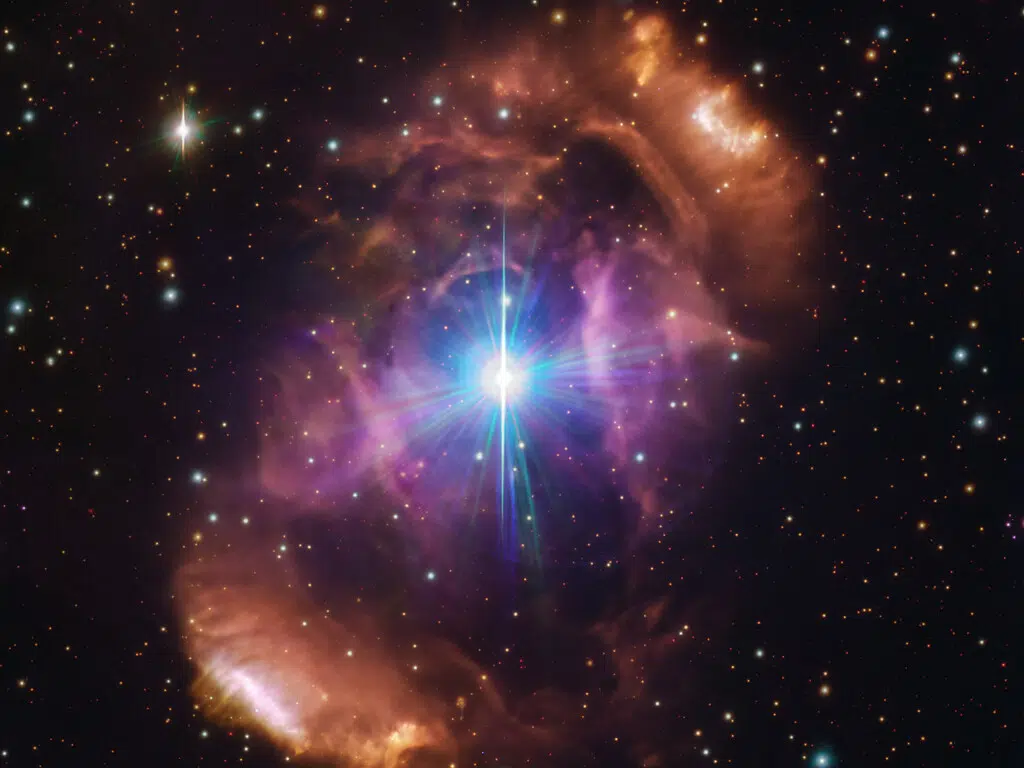
Scientists have uncovered a cosmic secret. There were three stars called HD 148937. Now, only two remain. They appear unusual because they used to be part of a trio.
Researchers discovered that two of these stars collided, forming the stunning Dragon’s Egg nebula where they now reside. These stars, though, are an odd couple, linked by gravity in a unique celestial phenomenon.
Astronomer Abigail Frost from KU Leuven in Belgium and the European Southern Observatory in Chile expressed her fascination with the system.
She noted that it’s uncommon to find a nebula encircling two big stars, sparking curiosity about what might have occurred in this particular system. Upon analyzing the data, the intrigue only grew, according to Frost.
Each star may form a black hole after dying
Situated approximately 3,800 light-years away from Earth, this system comprises two immense stars revolving around each other in a 26-year cycle.
These stars are hefty, with one weighing about 29.9 times the mass of the Sun, while the other is around 26.6 times as massive. Based on this theory, these stars are so large that they’re expected to transform into black holes when they reach the end of their lifecycle.
The larger star in this duo holds a strange characteristic. Prior studies indicate that it possesses a magnetic field. This is quite unusual because stars exceeding approximately seven times the mass of the Sun typically lack the convective interiors necessary to sustain a magnetic field, unlike smaller stars.
Rätsel im Drachenei Nebel gelöst? Das Doppelsternsystem HD 148937 liefert nicht nur fantastische Bilder. Es ist auch außergewöhnlich. Astronomen haben jetzt seine wilde Vergangenheit erforsch.
nasa pic.twitter.com/okqFmqcFcy— F. Mosel🪐 (@friedhelm_mosel) April 13, 2024
This anomaly intrigued Frost and her team. They delved into nine years’ worth of observational data on the system, gathered using the ESO’s Very Large Telescope, along with archival data from the MPG/ESO 2.2-meter telescope. This comprehensive analysis enabled them to thoroughly understand the stars and their orbital dynamics, as reported by ScienceAlert.
Two stars in the same binary system normally have similar age
Upon closer examination, the researchers observed an anomaly. Typically, two massive stars in a binary system like this would be of similar age, originating from the same stellar nursery around the same period.
However, upon analyzing the chemical composition of the stars, which provides insights into their age, they discovered a notable contrast. The larger star seemed to be approximately 2.7 million years old, while its smaller companion appeared to be at least 4.1 million years old. This age gap is quite significant, as reported by ScienceAlert.
The presence of the nebula adds another layer to the research. Estimated to be around 7,500 years old, its existence is already unusual. Typically, nebulas like this form as stars approach the end of their lives. However, both stars at the core of this nebula are still in their prime.
Moreover, the nebula contains a significant amount of nitrogen, carbon, and oxygen—elements usually confined within stars rather than floating freely outside them.
One possible explanation for the magnetic properties of the massive stars is the merger of two smaller stars. Such an event could scatter internal star material into the surrounding space. Collectively, these findings strongly suggest that a merger of two smaller stars indeed occurred in the case of HD 148937, according to ScienceAlert.
See all the latest news from Greece and the world at Greekreporter.com. Contact our newsroom to report an update or send your story, photos and videos. Follow GR on Google News and subscribe here to our daily email!



